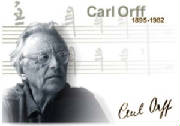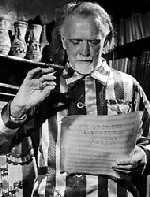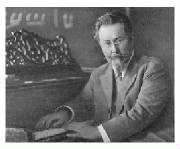|
|
 |
|

Orff Approach
Carl Orff (1895-1982) was a German composer and educator who developed a unique approach to music education. Orff defined
the ideal music for children as "never alone, but connected with movement, dance, and speech;not to be listened to, meaningful
only in active participation." Orff said, "Experience first, then intellectualize." Based on this ideal, the
Orff approach builds understanding of concepts and skills through connecting students with the music by experiencing it on
all levels. These levels include speech/chants, movement, singing, drama, and by playing pitched and unpitched instruments.
The Orff philosophy encourages children to experience music at their own level of understanding. Children are encouraging
learning in their natural environment of play. Improvisation is encouraged to allow children to explore the possibilities
in music.
The music used in the classroom is based on the children's own heritage with a combination of folk and composed music.
Here in America, our classrooms are multicultural. Orff philosophy embraces the folk music of all cultures. They are almost
all in the universal pentatonic scale. (Five note scale - separated by whole steps.) C Pentatonic would include the pitches
C D E G A. This is the most common scale used in Orff because it is easily used with the Orff instruments.
Elements of the Orff Approach
The Orff philosophy is a music education for the whole person. It is essentially an active music experiential approach.
Orff encourages creativity through the student's natural responses to music.
1. Rhythm
Orff begins with rhythm because it is the most basic of all the elements. He teaches this through natural speech patterns.
For the child, speaking, singing, music and movement are all naturally connected. The teacher then leads the students through
their own creative process. By connecting speech patterns to the rhythms, the child can master whatever meter or rhythm is
needed. This naturally also leads to body rhythm patterns and movement to the music.
2. Melody
Melody is taught in the same way. Simple intervals grow out of the natural pitches from the words. These intervals combine
to make a melody. This melody can later be put onto instruments. Orff said, "Experience first, then intellectualize."
Only after the playing has been taught does the teaching of notation occur.
3. Improvisation
Part of the playing and experiencing which is essential to the Orff approach is the element of improvisation. As frightening
as improvisation seems to be to adults, it is freeing to children. No rules! The teacher sets up boundaries in which the child
can create his or her own rhythm, melody, or dance.
Example for rhythm
The student has 8 beats to create his or her own rhythm.
Examples for melody with singing
Using the notes from "do" to "sol" create a song
Example for melody using an Orff instrument
Set up the instrument in C Pentatonic. This enables the player to improvise without hitting a "wrong" note.
The student has 8 beats to create his song.
Example for movement
The student has 16 beats to create some movement for a given piece of music or a given part of a story.
|
 |
|

Kodaly's Approach to Music Eduaction for Young Children
"A child's musical education must begin nine months before-not his own- but his mother's birth. Even those who feel
that this is somewhat of an exaggeration must admit that the first impressions are the most abiding. What a child has heard
in the first six years or life cannot be eradicated later. Thus it is too late to begin teaching at school, because a child
stores a mass of musical impressions before school-age, and if what is bad predominates, then his fate, as far as music is
concerned, has been sealed for a lifetime."; (Kodaly, 1951)
Kodaly's Philosophy
A. That true musical literacy - the ability to read, write, and think music - is the right of every human being.
B. That to be internalized, musical learning must begin with the child's own natural instrument; the voice.
C. That the education of the musical ear can be completed successfully only if it is begun early in kindergarten
and the primary grades; even earlier if possible.
D. That, as a child possesses a mother-tongue; the language Spoken in his home; he also possesses a musical mother-tongue
in the folk music of that language. It is through this musical mother-tongue that the skills and concepts necessary to musical
literacy should be taught.
E. That only music of unquestioned quality; both folk and composed; should be used in the education of children.
(Choksy, 1981, The Kodaly Context)
Kodaly's Music Education Program for Children
A. Unaccompanied Singing
B. Movement/Singing Games
C. Skill Development – Concept Building
D. Sound Discrimination
E. Inner Ear
F. Listening
Kodaly's Key Elements of the Concept
A. Singing
B. Folk Music
C. Solfege
|
 |
|

Dalcroze's Approach
A Dalcroze education is a musical training comprising the basic elements of music: rhythm, dynamics, tone and form. It
has three branches: Eurhythmics trains the body in rhythm and dynamics; Solfège trains the ear, eye and voice in pitch, melody
and harmony; Improvisation puts it all together according to the student's own invention- in movements, with voice, at an
instrument.
For children, and often for adult beginners, these three aspects of the Dalcroze work are integrated in a single class,
in which the students move, sing, and play as they engage in a variety of activities involving listening, responding, and
inventing.
As the students become more advanced, the three branches are formally separated, each having its own class. However, in
the spirit of musical wholeness that characterizes Dalcroze, each class includes all three aspects of the work.
Dalcroze training stimulates, develops, and refines all the capacities we use when we engage in music: our senses of hearing,
sight, and touch; our faculties of knowing and reasoning; our ability to feel and to act on our feelings. Coordinating these
capacities is the kinesthetic sense, the feedback mechanism of the nervous system which conveys information between the mind
and the body. The education of this sense to the purposes of music is at the heart of the Dalcroze work.
This approach, so radical in its inception one hundred years ago, has found its moment in the current explosion of interest
and research in music education. The newest discoveries and theories of learning point exactly to the teaching innovations
that Dalcroze proposed at the beginning of this century.
|
 |
|
|
 |
|
|
|
|
|
Jessica F. Wolfe * Private Music Lesson Instructor * All Instruments and Voice
|
|
|
 |

